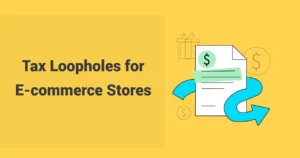Dropshipping feels like an easy win: no warehouse, low startup costs, and you can sell pretty much anything from anywhere. But then tax season comes up, and it’s not so simple anymore. If you’re running a dropshipping gig in the USA, whether on Shopify, Amazon, or WooCommerce, taxes are part of the deal. Mess them up, and you’re stuck with fines. Get them right, and you’re free to focus on growing your store.
This guide is here to make dropshipping tax in the USA clear and simple. Do dropshippers pay taxes in the USA? Yes, and I will show you how it works. We’ll cover dropshipping sales tax rules USA, income tax, some sweet deductions, and even cross-border tax for dropshippers if you’re selling to US folks from abroad. Plus, we’ll point you to SAL Accounting for tricky cross-border help. Let’s get started!
Quick Takeaways
- Sales Tax: You collect sales tax under dropshipping sales tax rules USA when you hit a state’s nexus, like $100,000 in sales, with rates from 0% to 11%.
- Income Tax: Do dropshippers pay taxes in the USA? Yep, income tax for dropshipping businesses hits profits at 10% to 37% federally, plus 15.3% self-employment tax unless you’re an S-Corp.
- Source Tax: With dropshipping tax in the USA, you might charge sales tax based on your location in states like Texas, think 6.25% to 8.25%, if you’re the seller there.
- Customs Tax: Cross-border tax for dropshippers includes customs tax on imports over $800, which you or your customer pays depending on shipping.
What’s Dropshipping, and Why Should You Care About Taxes?
Dropshipping is an online business where you sell stuff without ever holding it. A customer buys from your store (maybe on Shopify or eBay), you order it from a supplier, and they ship it straight to the buyer. It’s low-hassle and perfect for small business owners or US folks starting out.
Here’s the thing: taxes don’t care that you skip the warehouse. The IRS and state folks still want their cut. There are different types of taxes for dropshippers, like income and sales tax, and I will walk you through each one to keep things clear. Figuring out dropshipping tax in the USA keeps your store legit, saves you from penalties, and lets you keep building without the stress.
➜ Read more: “Dropshipping taxes in Canada Guide”
Income Tax for Dropshipping Businesses in the USA
Every dropshipper in the USA deals with income (self-employment) tax. It’s what you pay on your profits. If you’re flying solo, self-employment tax comes along for the ride.
How It Works
Your profits get hit with federal income tax at rates from 10% to 37% in 2025, depending on your earnings.
If you’re a sole proprietor (a common dropshipping start), you also pay self-employment tax: 15.3% total, split as 12.4% for Social Security and 2.9% for Medicare. Go S-Corp, and you can pay yourself a salary (taxed normally) and take the rest as profits, dodging some of that extra tax. Read more on self-employment tax.
Example: If you earn a $50,000 profit, you might owe $5,000 in federal income tax at the 10% bracket and another $7,650 in self-employment tax. That adds up to $12,650 before deductions. So, you’ll want to stash some cash aside to cover this chunk come tax time.
Note: Actual tax savings may vary based on specific circumstances.
State Income Tax
Forty-one states have income tax, but nine skip it: Alaska, Florida, Nevada, New Hampshire, South Dakota, Tennessee, Texas, Washington, and Wyoming. In Michigan, it’s 4.05%. If you have no profit, you don’t owe tax, but you still need to file.
Quarterly Payments
You’ll pay estimated taxes four times a year, April 15, June 15, September 15, and January 15, if you owe $1,000 or more. Skip it, and penalties hit (5% per month, up to 25%). Get details on estimated taxes.
🌟 Pro Tip: Set aside 25% to 30% of profits monthly for taxes. It keeps the quarterly crunch chill.
➜ Read more: “Best eCommerce Accounting Software in 2025”
Dropshipping Sales Tax Rules USA
Sales tax is huge. It’s what customers pay on orders, and you collect it if you’ve got nexus.
What is Nexus?
Nexus is your tie to a state that means sales tax duty. This sales tax nexus for eCommerce businesses comes in two types:
- Physical Nexus: An office or trade show booth in a state. Most dropshippers don’t deal with this since you don’t usually stock stuff. Learn about physical nexus.
- Economic Nexus for Dropshipping: Hits when you sell $100,000 or 200 transactions in a state. Forty-six states plus D.C. use this in 2025, think California ($500,000) or Kansas ($100,000, no transaction cap).
How to Collect It?
If you’ve got nexus, you collect sales tax with rates from 0% (Montana) to 11% (Louisiana spots). Amazon handles it in 45+ states thanks to marketplace laws, but you still track those sales. Other platforms might need manual setup.
Here’s a table showing sales tax rates and thresholds for some major states:
| State | Sales Tax Rate | Economic Nexus Threshold |
| California | 7.25%–10.25% | $500,000 |
| Texas | 6.25%–8.25% | $500,000 |
| New York | 4%–8.875% | $100,000 or 200 transactions |
| Florida | 6%–7.5% | $100,000 |
| Kansas | 6.5%–10.5% | $100,000 (no transaction min) |
Example: If you sell $120,000 worth of goods in New York, you’ll collect sales tax between 4% and 8.875% on each order. That’s what you’ll send to the state. Therefore, tracking your sales by state is key to staying on top of this.
🌟 Pro Tip: For sales tax for Shopify dropshipping, turn on Shopify Tax in Settings > Taxes. It auto-collects sales tax at checkout and keeps rates updated, but you’ll still need to file and send the cash to the states yourself. Tools like TaxJar ($19 a month) can track nexus and collect tax too. Contact our Shopify accountants for more information.
| Case Study: Texas Dropshipper Cuts Tax Bill with Smart PlanningThe Problem: A guy from Dallas reached out to me super stressed. “My fitness store started as a hobby but now makes $25,000 monthly, and I’m clueless about taxes,” he said. After 18 months on Shopify with no tax plan, he hit sales thresholds in several states without knowing it. He was scared he’d face huge fines or have to close shop. What We Did: Looking at his sales, I spotted the issue right away—he had nexus in 7 states, including California and New York. We quickly got him registered for sales tax permits in these states. I always tell folks that coming clean with tax offices shows you’re trying to do right. We set up TaxJar to handle his sales tax automatically and made a simple calendar for filing deadlines. For income taxes, we made him an S-Corp, which most dropshippers miss out on. The Result: By filing before any audit notices came, he avoided about $12,000 in penalties. The S-Corp switch saved him roughly $7,300 in self-employment taxes in year one. “I couldn’t sleep worrying the IRS would come knocking,” he told me recently. “Now I spend maybe an hour monthly on tax stuff.” He put those savings back into his business, which grew 63% the next year. |
➜ Read more: “Shopify Seller Tax Guide (2025)”
Source Tax in Dropshipping Tax in the USA
Source tax is a sneaky twist on sales tax, based on where you’re at, not the customer.
What’s Source Tax?
In 10 states, sales tax is origin-based, meaning you charge your local rate. Here are some examples:
- Arizona (like Phoenix at 8.6%)
- Texas (6.25% to 8.25%)
No matter where your buyer is in those states, that’s the rate you use. It’s part of dropshipping tax in the USA if you’re in one of these spots. Most states (46) use destination-based rules instead. Explore sourcing details.
Example: If you’re based in Texas where the sales tax rate is 6.25% to 8.25%, you’ll charge that on every sale under Texas rules. That’s the amount you’ll collect and send to the state. So, knowing your state’s tax setup helps you price stuff right.
Your Role
You collect and send it to your state, not the supplier. No double tax applies. You won’t pay source and destination sales tax on one sale.
🌟 Pro Tip: If you’re in a destination state like New York, source tax isn’t your worry.
Cross-Border Tax for Dropshippers: Customs Edition
Selling to US customers from abroad or sourcing overseas? Customs tax is your cross-border buddy.
Importing to the USA
The US skips duties on shipments under $800 (de minimis threshold). Above that, it’s 0% to 37.5%, based on the product. Chinese goods might catch extra Section 301 tariffs (up to 25%). Check customs rules.
Example: If you import a $1,000 gadget, you might face duties between $50 and $375, plus extra tariffs if it’s from China. That’s what gets tacked onto the cost. Therefore, keeping imports under $800 can save you and your customers a headache.
Who Pays?
Usually the buyer pays, but you can cover it with Delivered Duty Paid (DDP) shipping and bake it into prices. This ties into cross-border tax for dropshippers for international sellers or US dropshippers sourcing abroad.
Selling to US Customers from Abroad
If your sales cross a state’s economic nexus (like $100,000 in New York), you collect sales tax, even with no US base. Non-residents might need Form 1040NR for income tax, but treaties (like US-UK) can skip it. You’ll still pay back home. Explore tax treaties.
Example: If a UK dropshipper sells $150,000 to California using a US supplier, they’ll collect California sales tax at 7.25% to 10.25% on those orders. They might avoid US income tax thanks to the US-UK treaty but still owe UK VAT back home. So, checking tax treaties can cut your bill big time.
🌟 Pro Tip: Cross-border taxes get messy fast. Our cross-border experts can keep it simple.
| Case Study: UK Seller Fixes US Tax TroublesThe Problem: A UK client called me freaking out. “I’ve been selling beauty products to Americans for a year, and California just hit me with a $14,500 tax bill!” His Shopify store used suppliers in China and the US with no clue about American taxes. His business was booming—making $400,000 yearly in US sales—but he wasn’t collecting any sales tax from US buyers. What We Did: This is a common mess for foreign sellers. We checked his sales and found he had tax obligations in 12 states. I showed him how the US-UK tax treaty could prevent double taxation on his income. We got him registered for sales tax permits and set up Shopify to handle the weird US tax rates. I also found he was paying too much in customs fees on several products. The Result: We talked California into dropping the penalties, saving him $3,800. By keeping most shipments under the $800 customs-free limit, we cut his import costs by 22%. “I thought I’d have to shut down my US business,” he told me recently. His US sales jumped 47% because he could price better without the customs costs. He now spends just 2 hours monthly on US taxes, and the tax treaty saves him about £8,900 yearly on UK taxes. |
➜ Read more: “How to File Your U.S. Tax Return While Living in Canada”
Dropshipping Tax in the USA: Deductions to Save You Money
Here’s some good news: deductions can shrink what you owe. Check out what dropshippers can use:
Common Deductions
These are your everyday savings:
- Cost of Goods Sold (COGS): Cash you pay suppliers.
- Marketing: Ads on Facebook, Google, or influencer deals.
- Platform Fees: Your Shopify, Amazon, or WooCommerce costs.
- Shipping: Boxes, labels, fulfillment fees.
- Home Office: Part of your rent or utilities if you work from home (like $5 per square foot, up to 300 square feet). Learn about home office deductions.
Bigger Wins
Want more? These can save you even bigger:
- Section 179: Write off up to $1,160,000 (2023 cap) for gear like computers.
- Qualified Business Income (QBI): Take up to 20% off your income, though it fades out above $170,050 (single) or $340,100 (joint). Dive into QBI details.
- Charitable Donations: Give to a 501(c)(3) charity and deduct some of it.
Example: If you spend $5,000 on ads and $2,000 on Shopify fees, you can knock $7,000 off your taxable income. That’s less profit the IRS can tax. Therefore, keeping receipts for every expense is a smart move to max out these savings.
➜ Pro Tip: Save those receipts. Digital copies work fine. Our ecommerce bookkeepers can help you grab every deduction.
How to File Taxes, Stay Compliant and Avoid Trouble
Keeping up with taxes is a must. Here’s how to do it right.
1. Register for a Sales Tax Permit as a Dropshipper
If you’ve got nexus in a state, sign up for a sales tax permit online through the state’s revenue site. You’ll need:
- Your business details (EIN or SSN)
- Estimated sales numbers
- Sometimes a small fee (or none)
Filing happens monthly, quarterly, or yearly, and late filings can cost you 5% to 25% in penalties. Find state registration info.
2. File Taxes for Your Dropshipping Business
- Income Tax: Use Form 1040 (sole proprietor) or 1120-S (S-Corp) yearly, plus quarterly estimates.
- Sales Tax: Send it through state portals, even if you made nothing.
🌟 Pro Tip: Try QuickBooks ($30 a month) or Xero ($12 a month) to make filing easier. If you’re struggling with tracking your sales across multiple states, our small business tax accountants can help you.
➜ Read more: “How to File Sales Tax in the US“
Final Thoughts
Running a dropshipping business in the USA means tackling dropshipping tax in the USA. Do dropshippers pay taxes in the USA? You bet—sales tax with nexus, income tax on profits, and customs duties if global. Dropshipping sales tax rules USA vary by state, and cross-border tax for dropshippers adds twists, so staying on top is key. Taxes can feel wild, especially internationally, but SAL Accounting has your back. They’re e-commerce and cross-border pros, tracking nexus, finding deductions, and sorting VAT or treaties for US or global sellers.
With this guide, you’ve got tools to handle nexus, snag deductions, and file easy. Struggling with cross-border stuff? Contact us now and book a free consultation! We’ll keep your taxes smooth so you can keep selling.
FAQ: Your Dropshipping Tax Questions Answered
Yes, if you’ve got nexus, either physical or economic, in a state. It’s all about where you’re connected to customers. Check your sales to see where you might owe.
Economic nexus means you’ve sold enough (like $100,000) in a state to owe sales tax there. It hits dropshippers even without a physical spot. Big sales can mean big responsibilities.
You apply online through your state’s revenue website with your EIN and sales info. It’s usually quick and straightforward. Most states let you do it in a few clicks.
Shopify can if you set it up in Settings > Taxes, and Amazon does it in over 45 states thanks to marketplace laws. Always double-check your setup. It’s one less thing to stress about.
You pay federal tax (10% to 37%) plus 15.3% self-employment tax on profits, quarterly if you owe $1,000 or more. State tax depends on where you’re based. It adds up, so plan ahead.
You can deduct stuff like ads, shipping, platform fees, and a home office, plus big ones like Section 179 or QBI. It all adds up to less tax. Keep track of every penny spent.






